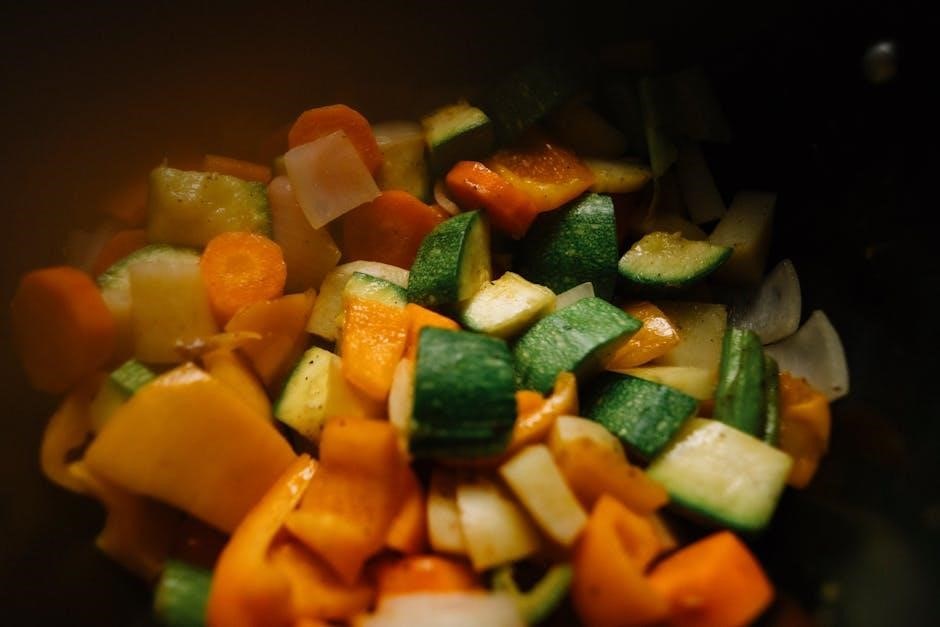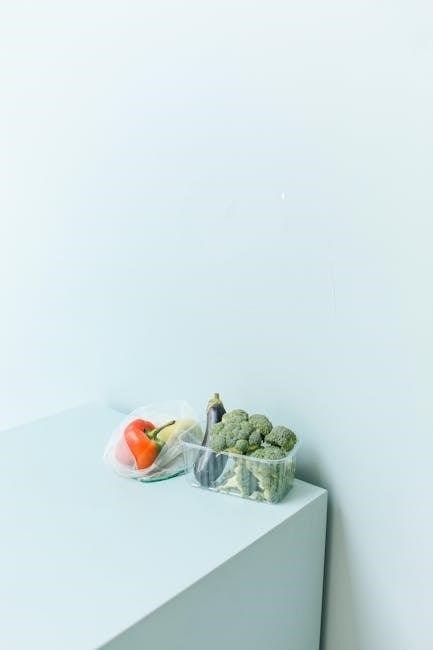Discover how incorporating anti-inflammatory foods into your diet can reduce chronic inflammation, a key factor in many health conditions. This guide offers a printable PDF list of anti-inflammatory foods to help you make informed choices and improve your well-being.
Understanding Chronic Inflammation and Its Impact on Health
Chronic inflammation is a prolonged immune response that can lead to various health issues, including heart disease, diabetes, and autoimmune disorders. Unlike acute inflammation, which protects the body, chronic inflammation damages cells and tissues over time. It is linked to oxidative stress and free radical damage, disrupting normal bodily functions. Conditions like arthritis, obesity, and even certain cancers are associated with chronic inflammation. Addressing this through diet is crucial, as specific foods can either fuel or reduce inflammation. Understanding the role of inflammation is the first step toward adopting a diet that promotes health and prevents long-term damage.
The Role of Diet in Reducing Inflammation
Diet plays a critical role in managing inflammation by providing essential nutrients and antioxidants that neutralize harmful substances. Anti-inflammatory foods, such as fatty fish, leafy greens, and berries, are rich in omega-3 fatty acids and polyphenols, which help reduce oxidative stress. A balanced diet can inhibit pro-inflammatory pathways and promote healing. By avoiding processed foods, refined sugars, and unhealthy fats, individuals can significantly lower their inflammation levels. Incorporating anti-inflammatory foods into daily meals supports overall health and reduces the risk of chronic diseases. A well-planned diet is a powerful tool for combating inflammation and improving long-term well-being.

Key Principles of an Anti-Inflammatory Diet
An anti-inflammatory diet focuses on whole, nutrient-dense foods, emphasizing antioxidants, omega-3s, and fiber. It avoids processed foods, sugary drinks, and unhealthy fats to reduce inflammation.
Foods That Combat Inflammation
Foods that combat inflammation include fatty fish like salmon and mackerel, rich in omega-3 fatty acids, which reduce inflammation. Leafy greens, such as spinach and kale, are packed with antioxidants. Berries like blueberries and raspberries contain polyphenols that fight oxidative stress. Turmeric, with its active compound curcumin, and ginger, with gingerol, are potent anti-inflammatory spices. Olive oil, especially extra virgin, is rich in oleocanthal, which inhibits inflammation pathways. Nuts and seeds, like walnuts and flaxseeds, provide healthy fats and fiber. Whole grains, legumes, and cruciferous vegetables like broccoli also contribute to an anti-inflammatory diet. These foods work synergistically to reduce inflammation and promote overall health.
Foods to Avoid That May Trigger Inflammation
Certain foods can trigger or worsen inflammation, including processed foods, refined sugars, and red or processed meats. Fried foods and those high in saturated or trans fats, such as pastries and fast food, should be limited. Alcohol, particularly in excess, can also promote inflammation. Foods containing artificial additives, preservatives, or excessive sodium may exacerbate inflammatory responses. Additionally, some individuals may experience inflammation from gluten-containing foods or dairy products. Avoiding these can help reduce inflammation and support overall health. Incorporating a printable list of anti-inflammatory foods can help guide healthier choices and minimize exposure to pro-inflammatory ingredients.

Best Anti-Inflammatory Foods to Include in Your Diet
Fatty fish, leafy greens, berries, turmeric, ginger, nuts, seeds, avocados, and olive oil are top anti-inflammatory foods. Incorporate these into meals for optimal health benefits and reduced inflammation.
Fatty Fish and Omega-3 Fatty Acids
Fatty fish are among the most potent anti-inflammatory foods due to their high levels of omega-3 fatty acids, particularly EPA and DHA. These nutrients play a crucial role in reducing inflammation by inhibiting the production of inflammatory molecules. Fatty fish such as salmon, mackerel, sardines, and tuna are excellent choices. Regular consumption of these fish can help lower chronic inflammation linked to heart disease, arthritis, and other conditions. Including fatty fish in your diet at least twice a week supports overall health and inflammation reduction. For convenience, refer to your printable anti-inflammatory foods list to track these essential additions to your meals.
Leafy Greens, Berries, and Antioxidant-Rich Foods
Leafy greens like kale, spinach, and arugula are rich in antioxidants, vitamins, and minerals that combat inflammation and oxidative stress. Berries, such as blueberries, strawberries, and raspberries, are packed with anti-inflammatory compounds like anthocyanins, which protect against chronic diseases. Incorporating these foods into your diet can help reduce inflammation and improve overall health. Other antioxidant-rich options include sweet potatoes, bell peppers, and cruciferous vegetables like broccoli. These foods are versatile and can be easily added to meals, smoothies, or snacks. For a quick reference, check your printable anti-inflammatory foods list to ensure you’re including these nutrient-dense options in your daily meals.
Additional Strategies for an Anti-Inflammatory Lifestyle
Hydration, quality sleep, and stress management are crucial for reducing inflammation. Pair these habits with regular physical activity and a balanced diet for optimal results. Stay consistent!
Hydration, Sleep, and Stress Management
Hydration is essential for flushing out toxins that can trigger inflammation. Aim to drink plenty of water throughout the day and incorporate water-rich foods like cucumbers and celery. Sleep plays a critical role in inflammation regulation, with poor sleep linked to increased inflammatory markers. Prioritize 7-9 hours of quality sleep by maintaining a consistent routine and creating a relaxing bedtime environment. Chronic stress also fuels inflammation, so practices like meditation, yoga, or deep breathing can help mitigate its effects. Combine these habits with a balanced diet to enhance your body’s natural anti-inflammatory responses and promote overall well-being.

Practical Guide to Incorporating Anti-Inflammatory Foods
Start with meal planning using a printable anti-inflammatory foods list. Focus on grocery shopping for fresh, whole ingredients and avoid processed items to simplify your transition.
Meal Planning and Grocery Shopping Tips
Effective meal planning begins with a structured approach. Start by identifying your dietary goals and preferences, then create a weekly menu that incorporates anti-inflammatory foods. Use a printable list of anti-inflammatory foods to guide your grocery shopping, ensuring you stock up on essentials like leafy greens, fatty fish, and whole grains. Organize your shopping list by categories to avoid missing items. Consider batch cooking to save time and maintain consistency. Remember to read food labels to avoid pro-inflammatory additives and opt for fresh, seasonal produce for maximum flavor and nutrition. This strategy will simplify your transition to an anti-inflammatory diet and keep you on track.

Importance of a Printable Anti-Inflammatory Foods List
A printable anti-inflammatory foods list provides a convenient and portable guide, helping you make informed dietary choices and easily incorporate anti-inflammatory foods into your daily meals;
How to Use the PDF List for Daily Reference
Print the anti-inflammatory foods list and keep it handy in your kitchen for quick reference. Laminate it for durability and place it on your fridge or a visible wall. Use it to plan balanced meals, ensuring you include anti-inflammatory foods like berries, leafy greens, and fatty fish. Refer to the list while grocery shopping to avoid inflammatory foods and stay on track. This guide simplifies decision-making, helping you maintain a diet rich in nutrients and antioxidants. By consulting it daily, you can reduce inflammation and improve overall health effortlessly. Make it a habit to check the list before meal prep or shopping for a sustainable, anti-inflammatory lifestyle.
Embrace an anti-inflammatory lifestyle by incorporating nutrient-rich foods. Download the free printable PDF list to guide your daily choices and start reducing inflammation for better health.
Download Your Free Printable Anti-Inflammatory Foods List PDF
Take the first step toward reducing inflammation with our free, expertly curated printable PDF list of anti-inflammatory foods. Designed by a Registered Dietitian, this guide includes essential foods like berries, leafy greens, fatty fish, and spices. Perfect for meal planning, it provides a clear, organized reference to help you make healthier choices. Print it out and keep it in your kitchen for daily inspiration. This PDF is your ultimate tool to start an anti-inflammatory diet, ensuring you never miss out on nutrient-rich options. Download now and begin your journey to a healthier, inflammation-free lifestyle!